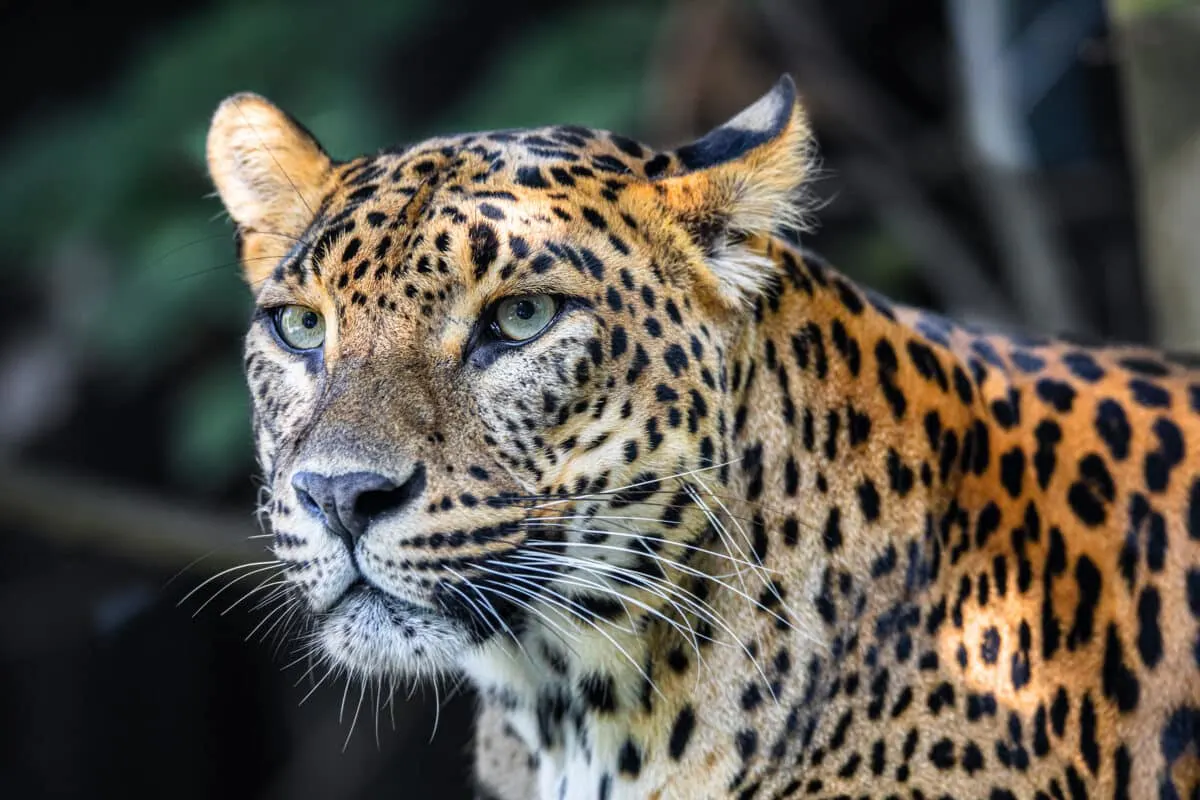Welcome to the Most Endangered Animals in South America. Jump right in!
South America is home to approximately 40% of the world’s largest plant and animal species. Tragically, this bountiful diversity is drastically diminishing. Here’s a list of the most endangered animals in South America that desperately need our attention.
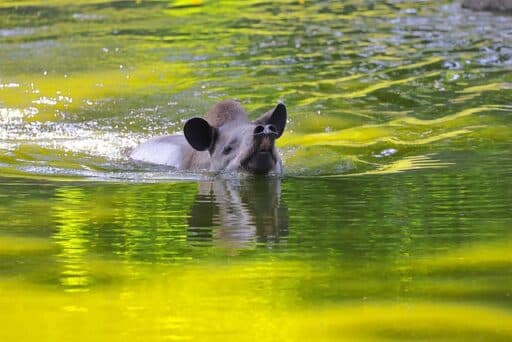
If you have had the opportunity to visit South America, you would have seen nearly every type of habitat on the planet: from the steamy tropical rainforests of the Amazon to mountains, deserts, grasslands, temperate forests, and finally, the fierce seas and ice floes of the sub-Antarctic. With such a varied landscape, naturally there is a wide variety of animal species.
However, the rapidly growing population, cruel land clearing for cultivation, and global warming have all impacted South America’s biodiversity. According to the IUCN Redlist of Threatened Species, nearly 30% of the continent’s organisms are on the verge of endangerment.
Here’s the top 10 list of emblematic South American endangered species:
Key Points
| Rank | Species | Average Size | Habitat | Conservation Status | Main Threats | Population Trend |
|---|---|---|---|---|---|---|
| 1 | Black-Headed Spider Monkey | Males: 7-9 kg (15-20 lbs) Females: 5-7 kg (11-15 lbs) | Central America, specifically Panama and Costa Rica | Endangered | Habitat loss and fragmentation Illegal pet trade | Declining |
| 2 | Floreana Mockingbird | Approximately 25 cm (10 inches) in length | Found exclusively on Floreana Island in the Galapagos archipelago | Critically Endangered | Predation by invasive species (such as rats and cats) | Declining |
| 3 | Mountain Viscacha | Head and body length: 40-55 cm (16-22 inches) Tail length: 15-25 cm (6-10 inches) | High-altitude regions of the Andes Mountains in South America | Least Concern | Habitat loss due to agriculture and livestock grazing | Stable |
| 4 | Magdalena River Turtle | Females: 45-50 cm (18-20 inches) shell length Males: 25-30 cm (10-12 inches) shell length | Magdalena River basin in Colombia and Venezuela | Critically Endangered | Habitat loss and degradation due to dam construction and mining | Declining |
| 5 | Rio Branco Antbird | Approximately 12-13 cm (4.7-5.1 inches) in length | Dense undergrowth of lowland rainforests in Brazil | Near Threatened | Deforestation and habitat loss | Decreasing |
| 6 | Daggernose Shark | Approximately 2.5-3 meters (8-10 feet) in length | Coastal waters and estuaries in the western Atlantic Ocean | Critically Endangered | Habitat destruction, overfishing, and bycatch | Declining |
| 7 | Jaguar | Length: 1.1-1.85 m (3.6-6.1 ft) Height: 63-76 cm (25-30 in) Weight: 56-96 kg (123-211 lbs) | Various habitats including rainforests, swamps, grasslands, and woodlands | Near Threatened | Habitat loss and fragmentation Poaching and illegal wildlife trade | Decreasing |
| 8 | Giant Otters | Length: 1.5 – 1.8 meters (4.9 – 5.9 feet) Weight: 22 – 32 kilograms (49 – 71 pounds) | Freshwater rivers, streams, and lakes in South America | Endangered | Habitat loss and degradation Illegal hunting and poaching | Decreasing |
| 9 | South American Tapir | Height at shoulder: 0.9-1.2 m (3-4 ft) Length: 1.8-2.5 m (6-8.2 ft) Weight: 150-300 kg (330-660 lbs) | Rainforests, swamps, grasslands, and cloud forests in South America | Vulnerable | Habitat loss and fragmentation Poaching for meat and hides | Decreasing |
| 10 | Pink Amazon Dolphin | Length: 1.5-2.5 meters (4.9-8.2 feet) Weight: 100-185 kilograms (220-408 pounds) | Freshwater rivers, lakes, and flooded forests of the Amazon and Orinoco river basins in South America | Near Threatened | Habitat degradation Illegal hunting Disturbance from boat traffic and fishing | Decreasing |
#1 Black-Headed Spider Monkey
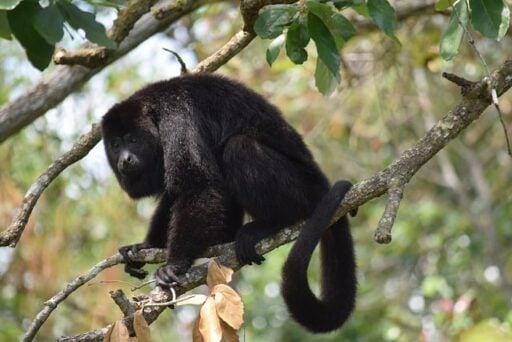
| Statistic | Description |
|---|---|
| Scientific Name | Ateles fusciceps |
| Average Size | Males: 7-9 kg (15-20 lbs) Females: 5-7 kg (11-15 lbs) |
| Average Height | Body length: 40-55 cm (16-22 inches) Tail length: 65-75 cm (26-30 inches) |
| Habitat | Central America, specifically Panama and Costa Rica |
| Diet | Mostly fruits, but also leaves, flowers, and insects |
| Behavior | Arboreal (primarily tree-dwelling) Highly agile and acrobatic -Lives in social groups called troops |
| Conservation Status | Endangered |
| Main Threats | Habitat loss and fragmentation Illegal pet trade |
| Population Trend | Declining |
The Black-Headed Spider Monkey is the most endangered animal in South America. They reside in humid tropical and subtropical forested areas 100-1,700 meters above sea level.
They consist of two subspecies:
- Ateles fusciceps fusciceps
- Ateles fusciceps rufiventris
A. f. rufiventris lives in areas 2,000-2,500 meters above sea level in deciduous, tropical, and rain forests. This species is a relatively large New World monkey species.
The size of their head and body, excluding the tail, is usually between 40 and 55 cm long. Their opposable tail ranges in length from 70 to 85 cm. On average, males weigh 9 kg, while females weigh 7,5 kg. Their brains weigh roughly 114.7 g.
The black-headed spider monkey is terrestrial and active during the day. It travels by trekking and branching. Females and males may court for as long as three days before mating or mate with multiple males.
Their pregnancies last up to 232 days. The newborn is carried on its mother’s back for 16 weeks and nursed until 20 months old. Females are sexually mature at 51 months, and males at 56 months. The mothers produce a litter of offspring every two to three years.
The International Union for Conservation of Nature (IUCN) lists the black-headed spider monkey as threatened as there is an estimated loss of more than half of the overall population between 2018 and 2063, resulting from illegal poaching and human invasion of its habitat.
#2 Floreana Mockingbird
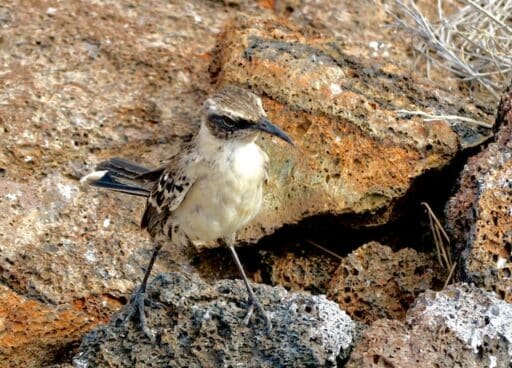
| Statistic | Description |
|---|---|
| Scientific Name | Mimus trifasciatus |
| Average Size | Approximately 25 cm (10 inches) in length |
| Weight | Around 50-60 grams (1.8-2.1 ounces) |
| Habitat | Found exclusively on Floreana Island in the Galapagos archipelago |
| Diet | Mainly feeds on insects, seeds, fruits, and nectar |
| Lifespan | Approximately 10-12 years in the wild |
| Conservation Status | Critically Endangered |
| Main Threats | Predation by invasive species (such as rats and cats) |
| Population Trend | Declining |
The Floreana mockingbird is the second most endangered animal in South America. It measures 25 to 28 cm in length. Males weigh 66 g on average, while females weigh around 60 g.
When fully grown, it still has a petite appearance: faint supercilium, dark patches on and below the eyes, and white cheekbones. Their head, upperparts, and tail are all grayish brown, with only a few darkened striations.
Their pubescent hair is whitish, with a dark spot on the corner of the breast and faint patches on the chest and flanks. Two noticeable white bars are present on the folded wing. The adolescent mimics the adult; however, its body is much more streaked.
The Floreana mockingbird was common on Floreana Island but had become obsolete by 1888 already. You can now observe this mockingbird on two small islands off the shore of Floreana, Campeón, and Gardner-near-Floreana. The islands sustain sparse vegetation across their beaches, arid scrub with succulents, and a few more plants inland.
The IUCN classified the Floreana mockingbird as Vulnerable species in 1994. It was recategorized as Critically Endangered in 2008 and then Endangered in 2017.
Experts blame rats, rodents, felines, dogs, and farm animals for eliminating this species of mockingbirds from Floreana in 1888. The population on the two tiny islands has varied with the occurrence or absence of El Nino events, but it is estimated to be more than 250 individuals currently and stable.
#3 Mountain Viscacha
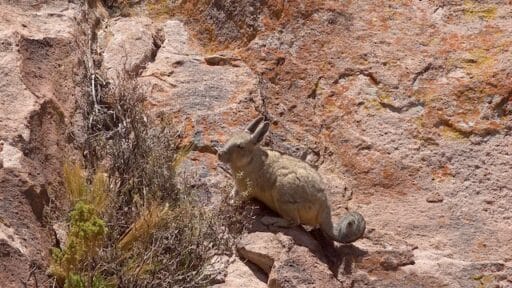
| Statistic | Description |
|---|---|
| Scientific Name | Lagidium viscacia |
| Average Size | Head and body length: 40-55 cm (16-22 inches)<br>Tail length: 15-25 cm (6-10 inches) |
| Average Weight | 2-3 kg (4.4-6.6 lbs) |
| Habitat | High-altitude regions of the Andes Mountains in South America |
| Diet | Herbivorous: Grasses, leaves, and other plant materials |
| Behavior | Social, lives in colonies or small groups |
| Lifespan | Around 8-10 years in the wild |
| Conservation Status | Least Concern |
| Main Threats | Habitat loss due to agriculture and livestock grazing |
| Population Trend | Stable |
The Mountain Viscacha, a rodent species found in southern Ecuador, is facing a critical situation as it is now considered the third most endangered animal in South America. This unique creature was only discovered in 2005 and officially described in 2009, surprising researchers by its presence more than 500 miles away from the nearest known population in central Peru.
The Mountain Viscacha, scientifically known as Lagidium ahuacaense, is a medium-sized animal resembling a rat. It has a distinctive appearance with its wooly gray-brown fur, long tail, and a striking black stripe running down its back. The creature’s dark brown whiskers above the mouth and eyes are thick and extended. Its undersides are creamy white, and the forefoot, covered in fur, is shorter than the hindfoot.
Sadly, this remarkable species is clinging to survival with only one known population remaining. The mountainous habitats of Cerro El Ahuaca, an uninhabited granite mountain in southern Ecuador, are the last refuge for these animals. With just a few dozen individuals left, they are now one of the most endangered animals in South America.
The Mountain Viscacha faces multiple threats in its shrinking habitat. The region’s practice of using fires to manage crop fields often gets out of control, resulting in severe damage to large parts of the viscacha’s home. Furthermore, the presence of grazing cattle poses an additional danger to the species. Despite being unknown to the local community and not targeted by hunters, the scientists who made the discovery have recommended that the Mountain Viscacha be listed as a threatened species, as its future survival hangs in the balance.
#4 Magdalena River Turtle
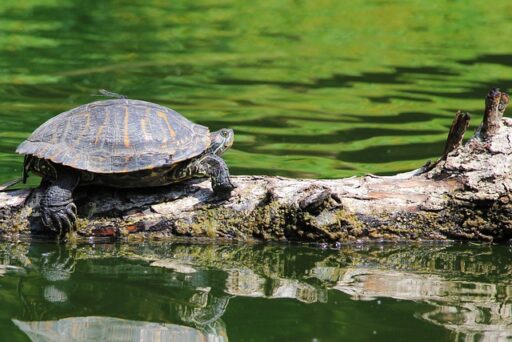
| Statistic | Description |
|---|---|
| Scientific Name | Podocnemis lewyana |
| Average Size | Females: 45-50 cm (18-20 inches) shell length |
| Males: 25-30 cm (10-12 inches) shell length | |
| Average Weight | Females: 15-20 kg (33-44 lbs) |
| Males: 5-10 kg (11-22 lbs) | |
| Average Lifespan | 60-80 years |
| Habitat | Magdalena River basin in Colombia and Venezuela |
| Diet | Omnivorous: plants, fruits, insects, fish, and carrion |
| Conservation Status | Critically Endangered |
| Main Threats | Habitat loss and degradation due to dam construction and mining |
| Population Trend | Declining |
| Reproduction | Females lay eggs in sandy riverbanks |
| Clutch size: 20-25 eggs | |
| Incubation period: 90-120 days |
Magdalena River turtles are an incredibly endangered species, currently ranking as the fourth most endangered animal in South America. Read more about the Animals on the Brink of Extinction in 2023.
These turtles display sexual dimorphism, meaning males and females have distinct physical characteristics. Their shells resemble shield-like plates, which are tough and predominantly brown.
Male Magdalena River turtles have brownish-gray face scales, while females possess red-brown head scales. In terms of size, adult males weigh around 1.5 kg and have an exoskeleton length of approximately 25 cm. On the other hand, females have an average weight of 5.7 kg and an exoskeleton length of about 33 cm.
In their natural habitat, these turtles primarily feed on plants. However, they occasionally switch to opportunistic insectivorous behavior, and juvenile turtles may even engage in piscivorous activities, consuming fish. Their average lifespan in the wild is around 10-15 years.
The International Union for Conservation of Nature (IUCN) has classified the Magdalena River turtle as “Critically Endangered” since 2015. It holds the unfortunate distinction of being one of the most threatened species within the Podocnemididae family and one of South America’s most endangered animals. Shockingly, their population has declined by over 80% in less than 25 years.
The decline of Magdalena River turtles can be attributed to various factors. Habitat destruction, environmental damage, over-harvesting, commercial exploitation, alterations in hydro-meteorological patterns due to electricity generation facilities, and the effects of global warming all play a role in their dwindling numbers.
While earlier conservation efforts proved ineffective or were seldom enforced, recent research has reemerged with the aim of determining the most effective strategies for their protection and recovery.
#5 Rio Branco Antbird
| Statistic | Description |
|---|---|
| Scientific Name | Cercomacra carbonaria |
| Average Size | Approximately 12-13 cm (4.7-5.1 inches) in length |
| Average Weight | Around 20-22 grams (0.7-0.8 ounces) |
| Habitat | Dense undergrowth of lowland rainforests in Brazil |
| Diet | Insects, spiders, and other small invertebrates |
| Plumage | Males: Solid black with a distinctive white wing patch<br>Females: Brown with white streaks on the throat and breast |
| Behavior | Terrestrial and secretive<br>Males perform duet vocalizations with their mates<br>Forages on or near the ground in search of prey |
| Conservation Status | Near Threatened |
| Main Threats | Deforestation and habitat loss |
| Population Trend | Decreasing |
The Rio Branco antbird is a slender bird with a long tail that inhabits river islands and dense gallery forests in northern South America and extreme southwestern Guyana.
Male Rio Branco antbirds exhibit primarily black plumage, complemented by white tail feathers and scalloping on the wings. In contrast, females have brownish-gray upper parts, a black tail, and a white throat streaked with black.
These birds prefer to remain concealed within dense vine tangles in the upper tree canopy and middle levels of the forest. They move slowly and cautiously in groups, searching for arthropods.
Their distinctive song consists of a series of 3-5 phrases, featuring a two-noted pattern with a hiccupping impact. It is somewhat similar to the song of the Gray Antbird but has a higher pitch, faster tempo, and less hoarseness.
Unfortunately, this species faces significant challenges. It has a limited distribution range and a relatively small population, earning it a designation as a “Threatened Species.” The Rio Branco antbird is considered one of the most endangered animals in South America.
Regrettably, the future outlook for this bird is grim. With potential land clearing in the Amazon basin, its population is expected to decline rapidly over the next few generations due to deforestation for cattle ranching and soy production, driven by the expansion of road networks.
#6 Daggernose Shark
| Statistic | Description |
|---|---|
| Scientific Name | Isogomphodon oxyrhynchus |
| Average Size | Approximately 2.5-3 meters (8-10 feet) in length |
| Average Weight | Around 70-100 kilograms (154-220 pounds) |
| Habitat | Coastal waters and estuaries in the western Atlantic Ocean |
| Diet | Small fish, crustaceans, and mollusks |
| Appearance | Slender body with a long, pointed snout (rostrum) |
| Conservation Status | Critically Endangered |
| Main Threats | Habitat destruction, overfishing, and bycatch |
| Population Trend | Declining |
The daggernose shark is a type of cartilaginous fish. It used to inhabit the warm waters of the central western Atlantic Ocean and the Caribbean Sea, specifically from Venezuela to northern Brazil. Unfortunately, its range has significantly declined, and it is no longer found in many regions of Brazil where it was once abundant. This shark has one of the smallest ranges among all elasmobranch species.
The daggernose shark is considered one of South America’s most endangered animals, with limited information available about its population status. The lack of recent data highlights the urgency of conservation efforts for this species.
While the exact feeding habits of the daggernose shark are still uncertain, some studies suggest that it preys on various marine creatures such as clupeids, sciaenids, sardines, clams, and croakers.
Due to its small eyes and elongated snout, it is believed that the daggernose shark relies more on sensory organs in its snout rather than visual acuity, especially in murky waters. This adaptation allows it to navigate and search for food effectively in such environments
Male daggernose sharks live to be about 12 years old, while females live to become about 20 years old. Female daggernose sharks give birth to litters of 3 to 7 pups every other year. Pupping tends to happen in South America during the monsoon season (January to June) after a year’s gestation period.
Commercial fishing operating across the daggernose shark’s range is the primary threat. The species was listed as critically endangered under the Endangered Species Act by NOAA Fisheries in 2017.
#7 Jaguar
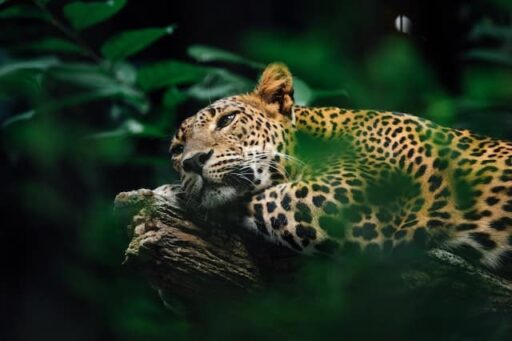
| Statistic | Description |
|---|---|
| Scientific Name | Panthera onca |
| Average Size | Length: 1.1-1.85 m (3.6-6.1 ft)<br>Height: 63-76 cm (25-30 in)<br>Weight: 56-96 kg (123-211 lbs) |
| Habitat | Various habitats including rainforests, swamps, grasslands, and woodlands |
| Distribution | Native to the Americas, found in South and Central America, as well as parts of the southern United States |
| Diet | Carnivorous; primarily feeds on large mammals such as deer, peccaries, and capybaras, but also preys on smaller animals and fish |
| Lifespan | In the wild: 12-15 years<br>In captivity: Up to 20 years |
| Reproduction | Gestation period: Approximately 90-110 days<br>Litters usually consist of 1-4 cubs |
| Conservation Status | Near Threatened |
| Main Threats | Habitat loss and fragmentation<br>Poaching and illegal wildlife trade |
| Population Trend | Decreasing |
This is the sole surviving member of the Panthera genus native to the Americas. It’s the biggest cat native to the Americas, the world’s third-largest, with a natural size of up to 1,8 m and a mass of up to 158 kg.
Its coat is distinguished by pale yellow to tan fur, surrounded by spots that transform into rosettes on the sides. However, some individuals have a melanistic black coat.
The jaguar’s mighty bite enables it to perforate turtle and tortoise shells and use an extraordinary killing technique: it attacks the skull of mammalian prey in between ears to deliver a deadly blow to the nervous system.
The jaguar is at risk of extinction because of habitat destruction and segmentation, unauthorized killing in retaliation for farm animals’ depredation, and illegal trade in jaguar anatomical structures.
The IUCN Red List has listed it as Near Threatened since 2002, as the jaguar population has likely declined by 20-25% since the mid-1990s.
Land clearing is a significant threat to jaguars throughout their range. The Argentine pampas, Mexico’s arid grasslands and the southwestern United States experienced the most significant rate of habitat loss.
Conservation efforts revolve around educating ranch owners and encouraging environmental conservation. Tourism activity setups to generate public interest in charming animals like the jaguar and generate income for wildlife conservation are significant steps to conserve their population. If such measures aren’t taken, they will remain one of South America’s most endangered animals and become extinct.
The large amount of habitat space they require is a substantial concern in jaguar ecotourism. Suppose the tourism industry aids in jaguar wildlife management, increasing its population. Some consideration must be given to how we will preserve existing ecosystems or establish new ones sufficient to accommodate more large numbers of jaguars.
#8 Giant Otters
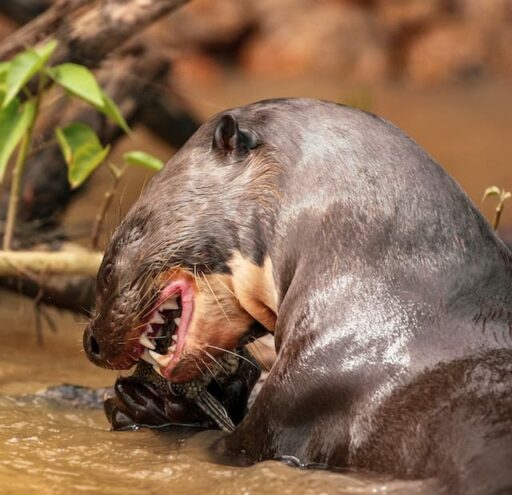
| Statistic | Description |
|---|---|
| Scientific Name | Pteronura brasiliensis |
| Average Size | Length: 1.5 – 1.8 meters (4.9 – 5.9 feet)<br>Weight: 22 – 32 kilograms (49 – 71 pounds) |
| Habitat | Freshwater rivers, streams, and lakes in South America |
| Diet | Mainly fish, but also crustaceans, amphibians, and small mammals |
| Lifespan | Around 10 – 15 years in the wild |
| Social Structure | Live in family groups called “holts” or “rafts” |
| Behavior | Highly social and vocal<br>Excellent swimmers and divers<br>Skilled hunters and cooperative feeders |
| Conservation Status | Endangered |
| Main Threats | Habitat loss and degradation<br>Illegal hunting and poaching<br>Water pollution and mining activities |
| Population Trend | Decreasing |
Giant otters are diurnal – extremely interactive mammals – that live in family groups of 2-20 individuals. They are the eighth most endangered animal in South America. A family comprises a mated couple and their progeny from several generations, with a habitat of 12 square kilometers.
Family members clarify a space of up to 50 square meters next to a river for their residence, reasonably close to feeding sites. They form extensive burrows beneath fallen logs and build one to five communal restrooms along the boundary of the building.
The scent from the animals’ anal glands then marks the formed territory. If trespassers break into the family’s territorial waters, the mum and dad will safeguard it and their family members. Otters are generally peaceful and mutually supportive in groups.
This species is monogamous, with couples staying together for life. Findings of captive animals have majorly demonstrated reproductive behavior. Although some mating occurs throughout the year, the breeding season peaks from late spring to summer. Pregnancy lasts 65-70 days, and the altricial young are born between late August and early October.
The general significant issues to the Giant otter are habitat division, loss, and environmental damage. This is so because the regions where they reside are deteriorated and severely damaged by deforestation, mineral extraction, and damming.
Overhunting for its precious fur until the late 1970s posed severe threats to the giant otters. Although not for fashion, the criminal killing continues. Frequently it is fishermen who see Giant otters as a threat to their catch.
If you are looking for more about otters read our article on The Biggest Otter Ever Found
#9 The South American Tapir
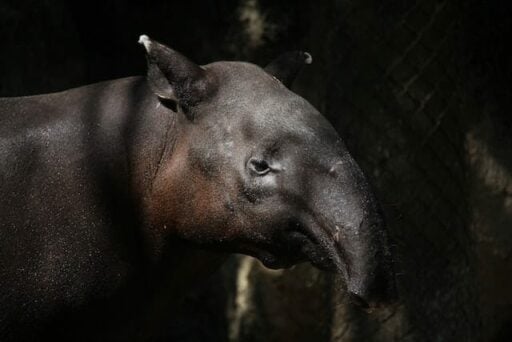
| Statistic | Description |
|---|---|
| Scientific Name | Tapirus terrestris |
| Average Size | Height at shoulder: 0.9-1.2 m (3-4 ft) Length: 1.8-2.5 m (6-8.2 ft) Weight: 150-300 kg (330-660 lbs) |
| Habitat | Rainforests, swamps, grasslands, and cloud forests in South America |
| Diet | Herbivorous, feeding on leaves, buds, fruits, and aquatic plants |
| Lifespan | Up to 25-30 years in the wild |
| Appearance | Large, stocky body with a short neck Dark brown to grayish-black color |
| Behavior | Solitary and primarily nocturnal Excellent swimmers Well adapted for life on land |
| Conservation Status | Vulnerable |
| Main Threats | Habitat loss and fragmentation Poaching for meat and hides |
| Population Trend | Decreasing |
The South American tapir, ranked as the ninth most endangered animal in South America, can be found in diverse habitats such as mangrove swamps, tropical forests, shrublands, and lagoons across Northern and Central South America.
These remarkable creatures have a lifespan of 31 to 34 years when living in the wild. South American tapirs are herbivores, primarily feeding on leaves and fruits. Their long and flexible snout helps them grasp food, detect scents, and stay safe, especially when submerged in water and encountering predators like jaguars.
Tapirs are generally solitary animals and do not have a specific name for their social groups. Breeding takes place between April and June, with sexual maturity reached by their third year. Females have a gestation period of 13 months and typically give birth to one offspring every two years.
Newborn South American tapirs weigh around 7 kilograms and are weaned over a span of approximately six months.
The population of South American tapirs is declining due to illegal hunting for their meat and hides, as well as habitat degradation. The species, scientifically known as T. Terrestris, is considered endangered and was officially designated as such by the U.S. Fish and Wildlife Service on June 2, 1970.
Nevertheless, compared to the other four tapir species, the South American tapir faces a relatively lower risk of extinction.
#10 Pink Amazon Dolphin
| Statistic | Description |
|---|---|
| Scientific Name | Inia geoffrensis |
| Average Size | Length: 1.5-2.5 meters (4.9-8.2 feet) Weight: 100-185 kilograms (220-408 pounds) |
| Habitat | Freshwater rivers, lakes, and flooded forests of the Amazon and Orinoco river basins in South America |
| Diet | Carnivorous, primarily feeding on fish |
| Lifespan | Up to 30-50 years in the wild |
| Appearance | Adults: Pink to light gray or even white coloration Newborns: Gray with a lighter underside |
| Unique Features | Long, slender body -Prominent forehead bulge -Snout is elongated and beak-like |
| Behavior | Social animals, living in groups called pods -Excellent swimmers and acrobatic in the water -Echolocation is used for navigation and hunting |
| Conservation Status | Near Threatened |
| Main Threats | Habitat degradation -Illegal hunting -Disturbance from boat traffic and fishing |
| Population Trend | Decreasing |
The Amazon Pink Dolphin, also known as the boto, is listed as the tenth most endangered animal in South America. It inhabits the rivers of Bolivia, Brazil, Colombia, Ecuador, Guyana, Peru, and Venezuela within the vast Amazon and Orinoco river basins.
These remarkable creatures are the largest among the four river dolphin species, reaching lengths of up to 2.5 meters and weighing up to 200 kilograms. They have sturdy pectoral fins, distinct tail flukes, and a unique hump instead of a long tail.
During courtship displays aimed at impressing females, male botos perform remarkable feats, such as leaping out of the water with branches or vegetation held in their mouths, or even raising live turtles above the surface. Female dolphins give birth to a single calf after an 11 to 15-month pregnancy. The young ones are nurtured for over a year, staying close to their mothers.
Unfortunately, the main threat to Amazon Pink Dolphins is human activity. They are poached for catfish bait or inadvertently trapped in gill nets, causing harm to their population. Conservation efforts are crucial to protect these fascinating creatures and ensure their survival in the wild.
It is a common freshwater marine mammal with a population estimated in the hundreds to thousands. Nevertheless, it is categorized as vulnerable in certain places due to reservoirs that fragment and endanger specific populations of dolphins and other risks such as river and lake pollution.
The Final Say:
South American wildlife includes many animals risking extinction, but numerous outstanding environmental protection programs are also in place.
These projects aspire to repair the damage caused by human intervention and regenerate the rainforest with previously dwindling species. So far, the programs have been largely successful; we can only hope this trend continues and the list of the most endangered animals in South America becomes shorter and shorter.
Thank you for reading this article and learning more about South America’s most endangered animals! To further expand your knowledge on endangered animals, read up on the 19 Most Endangered Amphibians and Animals in the Civil War.
Frequently Asked Questions (FAQs)
Q: What are the main threats to these endangered species?
A: The primary threats to endangered species in South America include habitat loss and fragmentation due to deforestation, illegal wildlife trade, poaching, pollution, climate change, and human-wildlife conflicts. These factors contribute to the decline of populations and the risk of extinction.
Q: Are there any conservation efforts in place to protect endangered species in South America?
A: Yes, there are numerous conservation efforts taking place in South America to protect endangered species. These include the establishment of protected areas, conservation projects focusing on habitat restoration and wildlife monitoring, educational initiatives, and efforts to combat illegal wildlife trade. Several local and international organizations work collaboratively to safeguard these species and their habitats.
Q: How can individuals contribute to the conservation of endangered species in South America?
A: Individuals can contribute to the conservation of endangered species in South America through various means. These include supporting conservation organizations financially or through volunteering, advocating for sustainable practices, spreading awareness about endangered species and their importance, and making responsible choices as consumers to minimize the demand for products that harm wildlife or their habitats.
Q: Can ecotourism play a role in supporting endangered species conservation in South America?
A: Yes, ecotourism can play a significant role in supporting endangered species conservation in South America. Responsible ecotourism practices that prioritize the well-being of wildlife and their habitats can generate income for local communities, provide incentives for conservation, and promote awareness about the importance of protecting endangered species. It is crucial to choose reputable tour operators and activities that prioritize sustainability and minimize disturbance to wildlife.
Q: Are there any success stories in the conservation of endangered species in South America?
A: Yes, there have been some success stories in the conservation of endangered species in South America. For example, efforts to protect and restore habitats have resulted in the recovery of populations of certain species, such as the giant otter and the Andean condor. These success stories highlight the importance of conservation initiatives and demonstrate that with dedicated efforts, it is possible to make a positive impact on endangered species populations.
- Magpie Bird Is Reunited with Her Dog Best Friend - April 24, 2024
- Dog Saves Another Dog From Drowning in Fish Pond - April 23, 2024
- Man On Motorbike Rescues Cat From Highway - April 23, 2024

